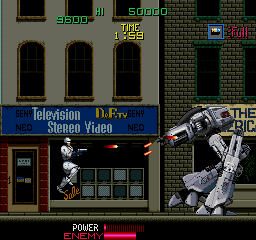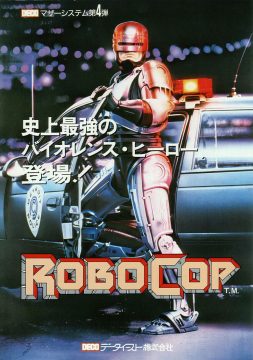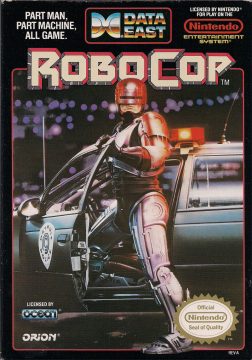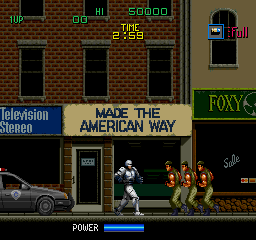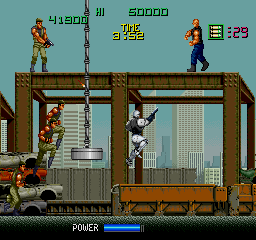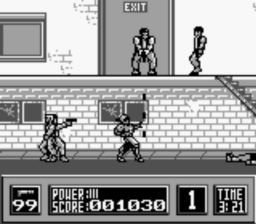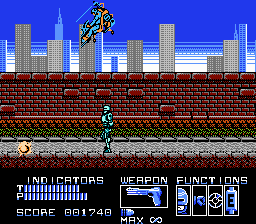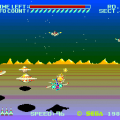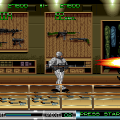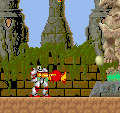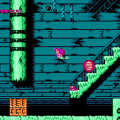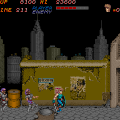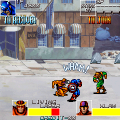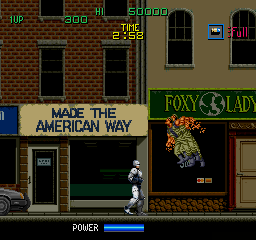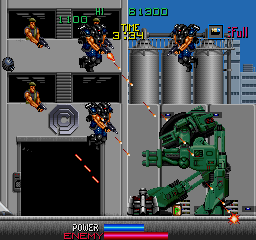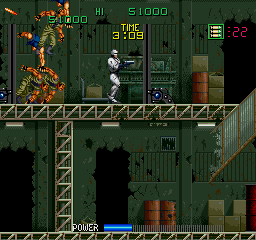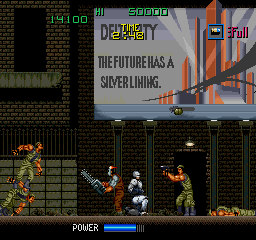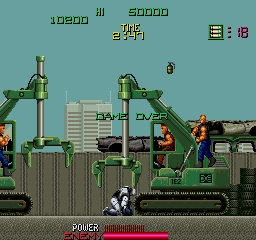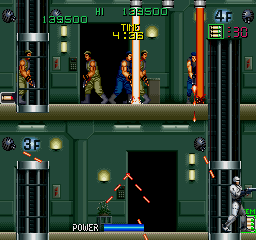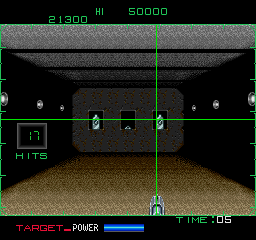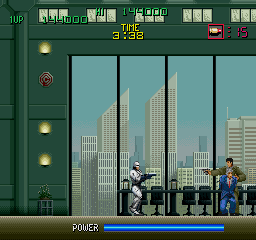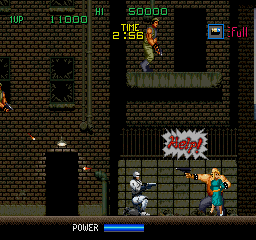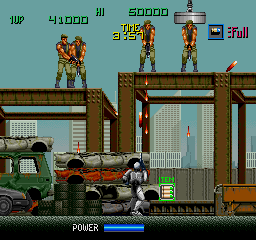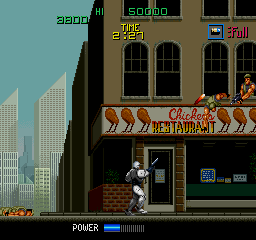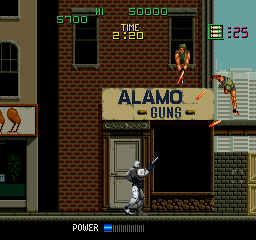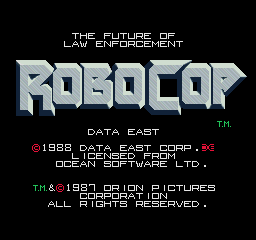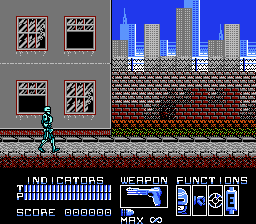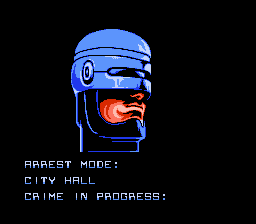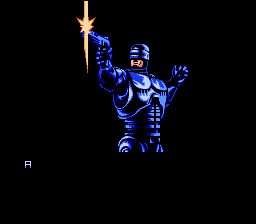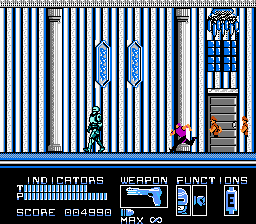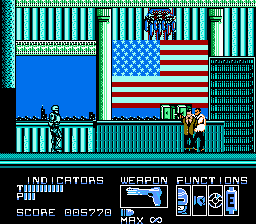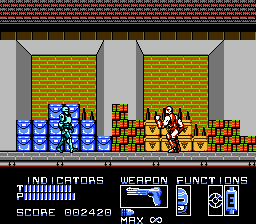- RoboCop
- RoboCop 2 (Arcade)
RoboCop is one of the defining action movies of the 80s. It tells the story of heroic police officer Lt. Alex Murphy, brutally gunned down in the line of duty, then resurrected as a no-nonsense, practically invincible cyborg. Beyond just cleaning up the streets of a corrupt Detroit, he also takes revenge on those who took his human life from him. Noted as being one of the most violent movies of its time, it of course spawned a franchise that included action figures, a child-friendly (?!?) cartoon, and of course, a number of video games.
The RoboCop license was purchased by Ocean, a British company known for publishing (typically rather shoddy) movie tie-ins. There are actually three separate games based on the original movie. These include an arcade game, originally developed by Data East and ported to a few computer platforms by Ocean; a different game developed specifically for European computers as well as the Game Boy, which is a loose interpretation of the arcade game; and an NES game by Sakata SAS, a team who often worked with Data East on its NES games, which was ported to the TRS-Coco.
The arcade game looks and feels like other Data East arcade sidescrollers like Bad Dudes and Sly Spy (In one of the post-level congratulatory messages, you are even called a “bad dude”). While at the beginning, you can only punch bad guys, only a few screens in and RoboCop will draw his gun, which will remain drawn for the entire rest of the game.
And so you slowly lumber forward, shooting everything that moves. There’s very little in the way of platforming, though in some levels you climb stairs or ride elevators. Some of the final areas are literally nothing but several floors of climbing, which is also where the game begins to run out of steam and grows a bit tedious. Because of the huge amount of enemies you’ll face, you can aim upwards, a rare luxury in many similar games of the era. Still, from a design standpoint, this isn’t exactly on the level of Contra – RoboCop moves slowly and proves inflexible when trying to dodge fire. You only get a single life, and run-ins with the more powerful enemies will deplete a huge chunk of it.
There are a few extra weapons to help murder your way through the thugs of Detroit. There are double shots and three-way shots, as well as a laser rifle that can blast through anything, though ammunition on all but the default pistol is limited. You’ll punch any enemies if you get close enough, though there aren’t situations where this is required. Beyond the normal mooks, you’ll also fight chainsaw-wielding enemies and jet pack-wearing soldiers, which provide a greater challenge.
The first level boss is the iconic ED-209 robot, though in many subsequent stages you fight against various vehicles and construction equipment. Some of these can trap you, requiring you to bash buttons to activate your super robot strength to break free. ED-209 and variations of it appear near the end of the game, too. On a few occasions you’ll also come across some enemies holding a civilian hostage. However, there’s no way to actually harm the innocent, so you can just carelessly fire away.
The visuals aren’t any technical achievement by 1988 standards, but they do replicate the grittiness of the movie almost perfectly. The first stage has a number of amusing storefronts – RoboCop begins the game underneath a sign that reads “Made the American Way”, and later on is a restaurant featuring roast chickens that are standing on their hind legs. The music mostly consists of an FM chiptune rendition of the theme music played on loop – well done but repetitive – but it’s also filled with digitized samples from the movie which add to the authenticity (“YOUR MOVE, CREEP!”).
Altogether, RoboCop is okay, though hardly a classic – it’s very middle of the line even by Data East’s standards. Still, it provides the chance to stomp through stages as RoboCop, blasting up bad guys, thereby scratching the itch of any RoboCop fan, more or less. The arcade release also looks and sounds (and plays) better than all of the other versions.
The arcade RoboCop game was used as a basis for the Atari ST, Amiga, and Apple II ports. These were both released in 1989, two years after the arcade game and the other computer versions. These are both surrounded by a border, making the playing field smaller. The graphics have also been redrawn and look strangely colorful compared to the relatively gritty look of the arcade game. There are also brief cutscenes showing news reports, using digitized actors from the movie. The Atari ST and Amiga versions are on the slow side but otherwise they’re okay ports. The Apple II port doesn’t look great, with choppy movement and a screen that incrementally scrolls when you reach the edge, but since the hardware wasn’t conducive for games, it does the best it can.
Most notable are a few extra minigames. Whenever you come across a hostage situation, the game switches to a first person perspective, where you have to target the bad guy using a cursor without hitting the civilian. The arcade game only uses this perspective in a target practice bonus round between levels. There’s also a segment where you need to recreate a facial image of a criminal, which feels out of place.
The second version of RoboCop was released for the Commodore 64, IBM PC, Amstrad CPC, ZX Spectrum, and Game Boy. Like the arcade game, it’s pretty simple – trudge forward and shoot stuff. There are four types of weapons, though, which you can switch between if you have ammo. There are only four stages in the C64 version, compared to the seven of the arcade game. It follows the same rough progression, from the city streets, through a junkyard, then to the OCP building. It also includes the hostage shooting gallery and face matching segments of the other computer ports. These ports do have good music, though, especially the oddly calming title theme. (Bizarrely, the same song was used in a commercial for Ariston-brand washing machines in England.) These are all okay run-and-guns considering their platforms, but they’re also overly difficult. This is especially true of the Commodore 64 version, which barely gives you enough time to finish some of the later stages.
The NES version, which was developed in Japan, seems to be mostly remembered because, despite being a sidescroller, RoboCop cannot actually jump. And it’s not intentionally restricting like Bionic Commando was – there’s just no use for it. Instead, the two face buttons are used for punching and (when you get your gun) shooting. Weirdly, in some areas you can use your gun but in others you can’t – it seems totally arbitrary. In addition to your health, you’re also facing off against a dwindling “time” meter, so you need to both hustle, and occasionally walk out of your way to get replenishment items. The levels are totally different from the other games, but again, similar in theme. There are still some scenes where bad guys take hostages (but still from a side-view). Unlike the arcade game, you actually need to avoid shooting the good guys here.
As far as licensed NES games go, RoboCop isn’t terrible, but it’s not exactly good either. There are only two songs in the game – a short rendition of the movie theme, and a boss tune, and they both get old extremely fast. For such a powerful character, RoboCop just looks and feels far too weak. He’s skinny, crappily animated, and his punches have no real reach. Shooting dogs is more difficult than it should be, as well, since it’s easy to accidentally fire downward instead of kneeling.
The cutscene visuals aren’t great, but the text interludes are hilarious. The Game Over screen reads “RoboCop is never discouraged. Let’s challenge again!” Upon re-enacting the end of the movie, as RoboCop kills OCP president Dick Jones as bloodlessly as possible, the end screen reads “Thank you for your cooperation. Stay out of trouble.”
